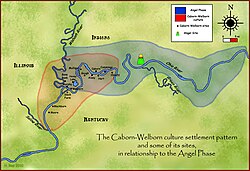 Caborn-Welborn culture and some of its larger sites. Hovey Lake is in the center of the red area | |
| Location | Posey County, Indiana, United States |
|---|---|
| Region | Posey County, Indiana |
| Coordinates | 37°49′49.37″N87°57′13.43″W / 37.8303806°N 87.9537306°W |
| History | |
| Founded | 1400 |
| Abandoned | 1650 |
| Cultures | Caborn-Welborn variant of the Mississippian culture |
| Site notes | |
Hovey Lake-Klein Archeological Site (12 PO 10) is an archaeological site of the Caborn-Welborn variant of the Mississippian culture. Hovey Lake-Klein Archeological Site is located on the west bank of Hovey Lake, a backwater lake near the Ohio River close to its confluence with the Wabash River. The site was an extensive village occupation dating between 1400 and 1650 CE.

